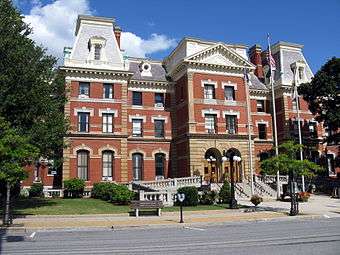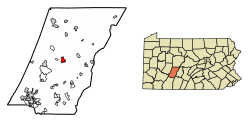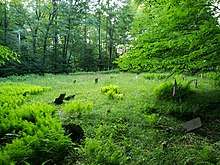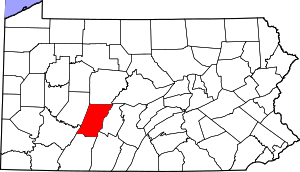Ebensburg, Pennsylvania
Ebensburg is a borough and the county seat of Cambria County in the U.S. state of Pennsylvania.[3] It is located 25 miles (40 km) west of Altoona and surrounded by Cambria Township. It is situated in the Allegheny Mountains at about 2,140 feet (650 m) above sea level. Ebensburg is located in a rich bituminous coal region. In the past, sawmills, tanneries, wool mills, and a foundry operated there. The number of residents in 1900 was 1,574, and in 1910, 1,978. The population was 3,351 at the 2010 census.[4] It is part of the Johnstown, Pennsylvania Metropolitan Statistical Area.
Ebensburg, Pennsylvania | |
|---|---|
Borough | |
 The Cambria County courthouse in Ebensburg | |
 Flag  Seal | |
| Motto(s): Crossroads of Cambria | |
 Location of Ebensburg in Cambria County, Pennsylvania. | |
 Ebensburg Location of Ebensburg in Cambria County, Pennsylvania. | |
| Coordinates: 40°29′11″N 78°43′32″W | |
| Country | United States |
| State | Pennsylvania |
| County | Cambria |
| Settled | 1796 |
| Incorporated | 1825 |
| Government | |
| • Type | Borough council |
| • Mayor | Randy Datsko |
| Area | |
| • Total | 1.69 sq mi (4.37 km2) |
| • Land | 1.66 sq mi (4.29 km2) |
| • Water | 0.03 sq mi (0.08 km2) |
| Elevation | 2,140 ft (650 m) |
| Population (2010) | |
| • Total | 3,351 |
| • Estimate (2019)[2] | 3,054 |
| • Density | 1,844.20/sq mi (711.88/km2) |
| Time zone | UTC-5 (Eastern (EST)) |
| • Summer (DST) | UTC-4 (EDT) |
| ZIP code | 15931 |
| Area code(s) | 814 |
| FIPS code | 42-22144 |
| Website | www |
History
Ebensburg originated in November 1796, when Congregational minister Rhees Lloyd led a small party of 20 Welsh people from Philadelphia to the lands Morgan John Rhees had chosen for his colony. They selected an attractive spot in the tops of the Allegheny Mountains and there settled what would become Ebensburg, naming it for Eben Lloyd, who died in childhood.[5] Lloyd offered land to the government in exchange for Ebensburg becoming the county seat, which the government accepted. A nearby settlement by the name of Beulah sprouted just to the West of town with intentions of becoming the county seat. The town faded into obscurity and now all that remains is an old cemetery.
Ebensburg was described in the 1940 Pennsylvania guide as being:[6]
situated on a rise with streets sloping from its center...founded in the early 1800s by the Reverend Rees Lloyd, a religious dissenter and leader of Welsh immigrants. Ebensburg was chosen as the county seat in 1805 when it was found to be at the geographical center of Cambria County. In 1842 it was still a rarity to have church services conducted in English rather than the ancient Cambrian tongue. Once a popular resort, Ebensburg is now largely dependent on agriculture, though many residents work in neighboring mines.
— Federal Writers'Project, "Part III: Tours, Pennsylvania: A Guide to the Keystone State (1940)
According to the book Cambria County Pioneers (1910), a General William Rudolph Smith, son of William Rudolph Smith, and refereed to as "Captain" by residents, lived in the town of Ebensburg, Pennsylvania in the 1840s and raised a Company of men known as the Cambria Guards who would serve in the Mexican American War, but Smith could not go.[7] He was "universally accepted as an authority in literary matters and upon historical subjects particularly he was a veritable encyclopedia. His literary style was forcible, direct, and elegant."[8]

During the Civil War, men from Ebensburg served in the 133rd Pennsylvania Volunteer Infantry (particularly companies A, B and F)[9] and fought in Allabach’s brigade (Humphreys' 3rd Division) at Fredericksburg and Chancellorsville. In the Battle of Fredericksburg on December 13, 1862, the 133rd participated in the final charge on Marye’s Heights, suffering heavy losses.[10] As well, Company A -known as the Cambria Guards- of the 11th Pennsylvania Reserves haled from Ebensburg and surrounding towns in Cambria County. This company was about 80 men strong and its Captain was Robert Litzinger of Ebensburg. The 11th Pennsylvania Reserves saw action at the Battle of South Mountain, The Battle of Antietam, and the Battle of Gettysburg. Particularly on the second days fight at Gettysburg, the 11th participated in a counter-assault down the face of Little Round Top into The Wheatfield to drive out Confederates.[11] Ebensburg even had Medal of Honor recipients in the Civil War in the forms of Thomas Evans of Company D, and James Snedden from Company E of the 54th Pennsylvania. Evans "wrested the colors from a color bearer of a Tennessee regiment [sic], sending the color bearer to the rear."[12] Evans is buried at Bethel Cemetery in Ebensburg.

In February of 1915 most of downtown Ebensburg was wiped out "by fire which broke out in the pool room of the Mountain House. Every building in the block from the Mountain House to the county court house was destroyed. The loss is estimated between $250,000 and $300,000. The court house was not damaged although the buildings adjoining were destroyed. Fire companies from many northern Cambria towns were summoned to assist the Ebensburg company. The Johnstown city fire department also went to the scene. The buildings destroyed include the fine building of the Cambria Savings and company, several hotels, a livery barn, a bank building and a number of small office buildings. The telephone communications were cut off. The buildings destroyed were thirteen in number. A cigarette dropped in the poolroom the night previous is believed to have started the fire."[14] According to the Indiana Progress "Several buildings were dynamited to prevent the spread of the flames."[15] Taking into consideration the lowest cost estimate of $250,000, in 2020 it would have cost $6,402,920.79.
Education
In the borough of Ebensburg, there are three public and two private schools. The two private schools are Bishop Carroll High School and Holy Name Elementary. The public schools are Cambria High School, Central Cambria Middle School, and Cambria Elementary. The fourth school of the Central Cambria School District is located about 5 miles (8.0 km) west of the borough, off Route 22.
Geography
Ebensburg is located in the center of Cambria County at 40°29′11″N 78°43′32″W (40.486388, -78.725461).[16]
Three U.S. highways pass intersect around Ebensburg. U.S. Route 22 runs along the southern border of the borough, leading east 18 miles (29 km) to Hollidaysburg, south of Altoona, and west 72 miles (116 km) to Pittsburgh. U.S. Route 219 bypasses the borough to the west, with access from two exits (U.S. 22 and U.S. 422). US 219 leads north 58 miles (93 km) to DuBois and south 41 miles (66 km) to Somerset. Finally, the western portion of U.S. Route 422 begins at US 219 on the west side of Ebensburg and leads west 26 miles (42 km) to the borough of Indiana. Johnstown, the largest city in Cambria County, is 22 miles (35 km) to the southwest via US 219 and Pennsylvania Route 56.
According to the United States Census Bureau, the borough of Ebensburg has a total area of 1.7 square miles (4.4 km2), of which 1.7 square miles (4.3 km2) is land and 0.04 square miles (0.1 km2), or 2.13%, is water.[4]
Demographics
| Historical population | |||
|---|---|---|---|
| Census | Pop. | %± | |
| 1810 | 75 | — | |
| 1820 | 168 | 124.0% | |
| 1830 | 270 | 60.7% | |
| 1840 | 353 | 30.7% | |
| 1850 | 600 | 70.0% | |
| 1860 | 1,002 | 67.0% | |
| 1870 | 1,240 | 23.8% | |
| 1880 | 1,123 | −9.4% | |
| 1890 | 1,202 | 7.0% | |
| 1900 | 1,574 | 30.9% | |
| 1910 | 1,978 | 25.7% | |
| 1920 | 2,179 | 10.2% | |
| 1930 | 3,063 | 40.6% | |
| 1940 | 3,719 | 21.4% | |
| 1950 | 4,086 | 9.9% | |
| 1960 | 4,111 | 0.6% | |
| 1970 | 4,318 | 5.0% | |
| 1980 | 4,096 | −5.1% | |
| 1990 | 3,872 | −5.5% | |
| 2000 | 3,091 | −20.2% | |
| 2010 | 3,351 | 8.4% | |
| Est. 2019 | 3,054 | [2] | −8.9% |
| Sources:[17][18][19] | |||
As of the census[18] of 2010, there were 3,351 people and 1,612 households within the borough. The population density was 1,971.2 people per square mile (702.0/km²). There were 1,742 housing units at an average density of 1,024.7 per square mile (334.8/km²). The racial make-up of the borough was 98.27% White, 0.48% African American, 0.69% Asian, 0.12% Native American, 0.01% from other races, and 0.36% from two or more races. Hispanic or Latino of any race were 0.48% of the population.
There were 1,612 households, out of which 22.7% had children under the age of 18 living with them, 48.3% were married couples living together, 9.1% had a female householder with no husband present, and 39.3% were non-families. 35.3% of all households were made up of individuals, and 17.3% had someone living alone who was 65 years of age or older. The average household size was 2.23 and the average family size was 2.90.
In the borough the population was spread out, with 19.2% under the age of 18, 1.9% from 18 to 19, 6.4% from 20 to 24, 12.9% from 25 to 34, 17.4% from 35 to 49, 21.7% from 50 to 64, and 20.5% who were 65 years of age or older. The median age was 42 years. The population was 46.55% male, and 53.45% female.
Notable buildings
- Cambria County Courthouse[20]
- Headquarters of the Cambria County Solid Waste Management Authority
Notable people
- Alan Baylock, jazz composer, band leader, chief arranger, US Air Force Airmen of Note[21]
- Bill Hartack, Hall of Fame jockey
- William Pryce, U.S. Ambassador to Honduras
References
- "2019 U.S. Gazetteer Files". United States Census Bureau. Retrieved July 28, 2020.
- "Population and Housing Unit Estimates". United States Census Bureau. May 24, 2020. Retrieved May 27, 2020.
- "Find a County". National Association of Counties. Archived from the original on 2012-07-12. Retrieved 2011-06-07.
- "Geographic Identifiers: 2010 Demographic Profile Data (G001): Ebensburg borough, Pennsylvania". U.S. Census Bureau, American Factfinder. Archived from the original on March 12, 2015. Retrieved March 12, 2015.
- "Profile for Ebensburg, Pennsylvania". ePodunk. Archived from the original on 2017-07-01. Retrieved 2010-06-12.
- Federal Writers' Project (1940). Pennsylvania: A Guide to the Keystone State (1st ed.). New York: Oxford University Press. p. 393.
- Swank, James Moore (1910). Cambria County Pioneers. Philadelphia: Alan, Lane & Scott. p. 87.
- Swank, James Moore (1910). Cambria County Pioneers. Philadelphia: Alan, Lane & Scott. p. 89.
- "133rd Pennsylvania Volunteers, Company C Muster Roll". www.pa-roots.com. Retrieved 2016-03-14.
- "Civil War Index - 133rd Pennsylvania Infantry". www.civilwarindex.com. Retrieved 2016-03-14.
- Gibbs, Joseph. Three Years in the Bloody Eleventh: The Campaigns of a Pennsylvania Reserves Regiment.
- Official Records of the War of Rebellion. 1891. pp. 118–119.
- Beitler, Sue. "Ebensburg, PA Destructive Fire Throughout Town, Feb 1915". GenDisasters.com.
- "Ebensburg has Costly Fire". The Indiana Weekly Messenger. 1915-02-24.
- "EBENSBURG HAS $250,000 FIRE". The Indiana Progress. 1915-02-24.
- "US Gazetteer files: 2010, 2000, and 1990". United States Census Bureau. 2011-02-12. Retrieved 2011-04-23.
- "Census of Population and Housing". U.S. Census Bureau. Retrieved 11 December 2013.
- "U.S. Census website". United States Census Bureau. Retrieved 2008-01-31.
- "Incorporated Places and Minor Civil Divisions Datasets: Subcounty Resident Population Estimates: April 1, 2010 to July 1, 2012". Population Estimates. U.S. Census Bureau. Archived from the original on 17 June 2013. Retrieved 11 December 2013.
- "Cambria County Courthouse". National Register of Historic Places. 1980-06-30. Retrieved 2020-04-05.
- "Alanbaylock.com". Gloria Douglas. 2019-08-23. Retrieved 2020-04-05.
